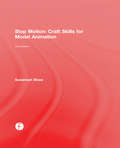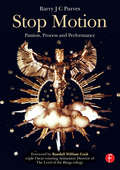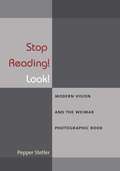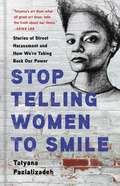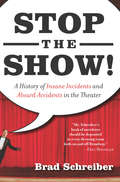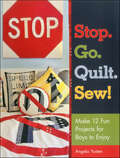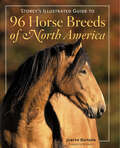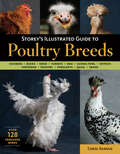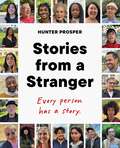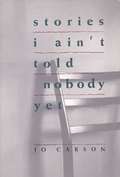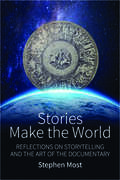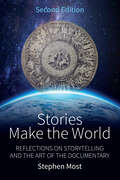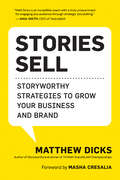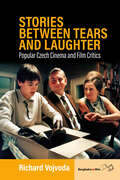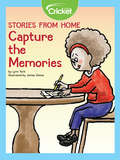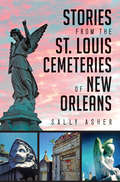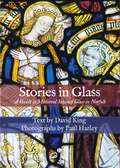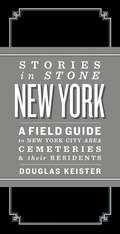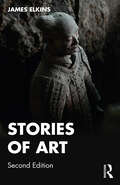- Table View
- List View
Stop Look Breathe Create
by Wendy Ann Greenhalghh3>Stop Look Breathe Create is a simple four-step process for exploring mindfulness through creativity, and in turn, developing creativity through mindful practice.The book engages the reader with ten everyday subjects, from 'The Ground Beneath Our Feet' to 'Returning Home' and for each of these there are three projects: one drawn, one photographic, one written. All are based on the effective mindfulness techniques that Wendy Ann has developed in her successful workshops and courses, and the book is filled with simple techniques and ideas to help the reader enjoy their artistic endeavours while being in the moment.A timely introduction to the benefits of mindfulness through creativity, Stop Look Breathe Create offers an oasis of calm in a frantic world.
Stop Motion: Craft Skills For Model Animation
by Susannah ShawStop motion animation is a challenging and time-consuming skill that requires patience, adaptability, and a close eye to detail. Stop Motion: Craft Skills for Model Animation, 3rd Edition is the essential guide to help stop motion animators overcome these challenges of this highly-skilled craft. Author Susannah Shaw provides a step-by-step guide to creating successful stop motioin films. Starting with some basic exercises, the reader will learn about developing a story, making models, creating sets and props, the mechanics of movements, filming postproduction, and how to set about finding that first elusive job in a modern studio. Key Features Interviews with current stars, step-by-step examples, coverage of Rapid Prototyping and Dragonframe Software
Stop Motion: Passion, Process and Performance
by Barry J PurvesBe inspired by award-winning animator Barry Purves' honest insight into the creative process of making stop motion animations, using his own classic films to illustrate every step along the way. With Barry's enthusiasm for puppets in all their many guises and in-depth interviews from some of the world's other leading practitioners, there is advice, inspiration and entertainment galore in Stop Motion: Passion, Process and Performance. And there's more! Many of the artists and craftsmen interviewed have contributed their own specially drawn illustrations - showing their inspirations, heroes and passion for their craft. These beautiful images help make the book a truly personal journey into the heart of the animation industry with broad appeal for anyone with a love of animation.
Stop Reading! Look!: Modern Vision And The Weimar Photographic Book
by Pepper StetlerIn the second half of the Weimar period (1918-33), photographers produced books consisting almost entirely of sequenced images. The subjects ranged widely: from plants and nature to the modern metropolis, from exotic cultures to the German Volk, from anonymous workers to historical figures. While many of the books were created by key practitioners and theorists of modern photography, scholars have rarely addressed the significance of the book format to modern conceptions of photographic meaning. The term "photo-essay" implies that these photographic books were equivalent to literary endeavors, created by replacing text with images, but such assumptions fail to explore the motivations of the books' makers. Stop Reading! Look! argues that Weimar photographic books stood at the center of debates about photography's ability to provide uniquely visual forms of perception and cognition that exceed the capacity of the textual realm. Each chapter provides a sustained analysis of a photographic book, while also bringing the cultural, social, and political context of the Weimar Republic to bear on its relevance and meaning.
Stop Telling Women to Smile: Stories of Street Harassment and How We're Taking Back Our Power
by Tatyana Fazlalizadehp.p1 {margin: 0.0px 0.0px 10.0px 0.0px; font: 12.0px 'Times New Roman'} p.p2 {margin: 0.0px 0.0px 0.0px 0.0px; font: 12.0px 'Times New Roman'} p.p3 {margin: 0.0px 0.0px 0.0px 0.0px; font: 12.0px 'Times New Roman'; min-height: 15.0px} The debut book from a celebrated artist on the urgent topic of street harassmentEvery day, all over the world, women are catcalled and denigrated simply for walking down the street. Boys will be boys, women have been told for generations, ignore it, shrug it off, take it as a compliment. But the harassment has real consequences for women: in the fear it instills and the shame they are made to feel. In Stop Telling Women to Smile, Tatyana Fazlalizadeh uses her arresting street art portraits to explore how women experience hostility in communities that are supposed to be homes. She addresses the pervasiveness of street harassment, its effects, and the kinds of activism that can serve to counter it. The result is a cathartic reckoning with the aggression women endure, and an examination of what equality truly entails.
Stop the Show!: A History of Insane Incidents and Absurd Accidents in the Theater
by Brad SchreiberStop the Show! is the first book to assemble humorous, frightening and bizarre anecdotes about the history of all that went wrong during live theatrical productions in the U.S. and the United Kingdom. It is the publishing equivalent of TV bloopers for the legitimate stage. This book includes stories from top directors, actors, playwrights and technicians from New York, Los Angeles, and points in between, to the United Kingdom, from the 19th century to today. There are stories about missed entrances and exits, onstage unscripted fights between performers, improvised lines, accidental pratfalls, falling scenery, and costume, lighting and makeup screwups. The backstage provides sordid tales of practical jokes, treachery, misplaced props, wild arguments, and generally the kinds of things Michael Frayn created for his farce about a theatrical disaster, Noises Off. This book doesn't leave out the theatergoers either, who snore, fight with each other, talk back to the performers, search for their seats, become suddenly ill, eat, drink, make merry, and are yelled at by the performers - all of which sometimes prompts the show to stop, even though we've always been told it must go on.
Stop. Go. Quilt. Sew!: Make 12 Fun Projects for Boys to Enjoy
by Angela YostenObserving the rules of the road Boys of all ages love their cars-celebrate their devotion to all things transit and stitch up some fun things for them to wear and use. Learn a new style of "scrap appliqué" using raw edge and reverse appliqué techniques. From toddlers to teens, boys (and girls too!) will love showing off these cool street sign and traffic signal designs. • Share your love of hand-sewn keepsakes with the boys in your life, too! • Full-sized patterns for a quilt, pillows, shirts, messenger bag, shower curtain, towels & more • Combine projects to create a fun traffic theme in any room
Store It!
by Mervyn KaufmanSTORE IT is the comprehensive guide to making, finding and organizing space in your home from the entryway to the attic.
Storey's Illustrated Guide to 96 Horse Breeds of North America
by Judith DutsonFrom the Pryor Mountain Mustang to the Tennessee Walking Horse, North America is home to an amazing variety of horses. In this lavish, photograph-filled guide, Judith Dutson provides 96 in-depth profiles that include each breed&’s history, special uses, conformation standards, and more. You&’ll learn about homegrown favorites like the Morgan, Appaloosa, and Quarter Horse, as well as exotic imports like the Mangalarga Marchador and the Selle Français. Take a continental horse tour without ever leaving your home.
Storey's Illustrated Guide to Poultry Breeds: Chickens, Ducks, Geese, Turkeys, Emus, Guinea Fowl, Ostriches, Partridges, Peafowl, Pheasants, Quails, Swans
by Carol EkariusMore than 128 birds strut their stuff across the pages of this definitive primer for intrepid poultry farmers and feather fanciers alike. From the Manx Rumpy to the Redcap and the Ancona duck to his Aylesbury cousin, each breed is profiled with a brief history, detailed descriptions of identifying characteristics, and colorful photography. Comprehensive and fun, Storey’s Illustrated Guide to Poultry Breeds celebrates the personalities and charming good looks of North America’s quirkiest barnyard birds and waterfowl.
Stories Behind the Great Traditions of Christmas
by Ace CollinsWonderfully written descriptions explaining many of our most valued Christmas traditions.
Stories From a Stranger: Every person has a story.
by Hunter ProsperA collection of one hundred deeply personal stories—covering love and heartbreak, growth and resilience—brought to life by the creator of the wildly popular TikTok account @HunterProsper. <P><P> Every person has a story. Dick knew that it was love at first sight when he saw Nancy across the church steps—they got married a week later and have been best friends ever since, still going strong over fifty years later. <BR><BR> Nathalia’s first boyfriend told her that her facial scars made her even more beautiful, and it gave her the confidence to become the strong woman she is today. <BR> When Ghada learned that her young son was ill, she refused to give up—he’s thriving over twenty years later. <P><P> We’re more alike than we are different. In Stories from a Stranger, Hunter Prosper—creator of the viral social media phenomenon of the same name—brings together these three and ninety-seven other unforgettable, never-before-published interviews that illuminate the depths of the human heart. He asks the questions that matter most: <BR> Who was your greatest love? <BR> What's the most painful thing you’ve been told? <BR> What do you see when you look in the mirror? <P><P> The answers reveal raw, breathtaking glimpses into lives filled with love, resilience, and hope. As an ICU nurse, Hunter has stood at the crossroads of life and loss, bearing witness to whispered confessions, final goodbyes, and moments of unexpected grace. In the midst of turmoil, he turned to storytelling—first to make sense of his own emotions, then to give voice to those who could no longer speak. What started as a simple question evolved into a movement, resonating with millions longing for connection. <P><P> Moving, humbling, and profoundly inspiring, Stories from a Stranger is more than a book—it’s a celebration of our shared humanity and the invisible threads that bind us together. <P><P> <B>New York Times Bestseller</B>
Stories I Ain't Told Nobody Yet
by Jo CarsonFifty-four monologues and dialogues, a remarkable distillation of rhythms and nuances from the region of the heart.
Stories Make the World: Reflections on Storytelling and the Art of the Documentary
by Stephen MostSince the beginning of human history, stories have helped people make sense of their lives and their world. Today, an understanding of storytelling is invaluable as we seek to orient ourselves within a flood of raw information and an unprecedented variety of supposedly true accounts. In Stories Make the World, award-winning screenwriter Stephen Most offers a captivating, refreshingly heartfelt exploration of how documentary filmmakers and other storytellers come to understand their subjects and cast light on the world through their art. Drawing on the author's decades of experience behind the scenes of television and film documentaries, this is an indispensable account of the principles and paradoxes that attend the quest to represent reality truthfully.
Stories Make the World: Reflections on Storytelling and the Art of the Documentary
by Stephen MostSince the beginning of human history, stories have helped people make sense of their lives and their world. Today, an understanding of storytelling is invaluable as we seek to orient ourselves within a flood of raw information and an unprecedented variety of supposedly true accounts. In Stories Make the World, award-winning screenwriter Stephen Most offers a captivating, refreshingly heartfelt exploration of how documentary filmmakers and other storytellers come to understand their subjects and cast light on the world through their art. Drawing on the author’s decades of experience behind the scenes of television and film documentaries, this is an indispensable account of the principles and paradoxes that attend the quest to represent reality truthfully.
Stories Sell: Storyworthy Strategies to Grow Your Business and Brand
by Matthew DicksWIN CUSTOMERS AND BUILD BRANDS THROUGH THE POWER OF STORYTELLING Moth GrandSLAM all-time champion storyteller, writer, and business coach Matthew Dicks presents a guide to using the power of storytelling for success in business of any type or size. Matt has found that the basic principles of effective storytelling are universal, teachable, and more crucial than ever for business communication. Jam-packed with examples, Stories Sell reveals the ingredients of a compelling story and then demonstrates how they can be incorporated into persuasive marketing copy, productive face-to-face conversations, effective sales pitches, and presentations that people actually want to hear. Topics include: • The three elements of a winning story: stakes, suspense, and surprise • Finding the right narrative structure (and why beginning at the beginning isn’t always the best method) • The power of being vulnerable: how admitting your mistakes can build rapport with audiences • When and how to use humor • Zigging while others zag: making yourself stand out from competitors Whether you’re an online marketer, advertising professional, salesperson, small business owner, independent contractor, or Fortune 500 executive, Stories Sell will teach you to find your voice and get your message across for maximum impact and profit.
Stories between Tears and Laughter: Popular Czech Cinema and Film Critics
by Richard VojvodaWhile histories of Czech cinema often highlight the quality of Czechoslovak New Wave films made in the 1960s, post-socialist Czech cinema receives little attention. Through a methodology of historical reception, Stories between Tears and Laughter explores how attitudes towards post-socialist Czech cinema have shifted from viewing it as radical “art cinema” and more towards popular cinema. By analyzing publicity materials, reviews, and articles, Richard Vojvoda offers a new perspective on the notions of cultural value and quality that have been shaping the history of post-socialist Czech cinema.
Stories from Home: Capture the Memories
by Lynn YorkTo unearth the stories of buried treasures, all you have to do is ask the right questions.
Stories from the St. Louis Cemeteries of New Orleans (Landmarks)
by Sally AsherThe tombs and graves of the St. Louis Cemeteries rise from the ground, creating labyrinthine memorials aptly dubbed "cities of the dead." Most are in even rows with quaint street names. Some are of crumbling brick and broken marble. Others are miniature mansions clad in decorative ironwork with angelic guardians. Grand or humble, each is a relic of the story of New Orleans. Politicians, pirates, Mardi Gras Indian chiefs and one voodoo queen rest below. In an unprecedented inquiry, author Sally Asher reveals the lives within the mysterious and majestic tombs of the St. Louis Cemeteries.
Stories in Glass: A Guide to Medieval Stained Glass in Norfolk
by David King Paul HarleyNorfolk's churches are home to some of the highest-quality and best-preserved medieval stained glass in Britain. Panels produced in the county's extensive and long-lasting workshops, centred in the historically important city of Norwich, can be found in some 270 buildings, including churches, museums and country houses. Moreover, recent research has revealed for the first time the original location of many of the panels now dispersed around the county. In Stories in Glass, Paul Harley and David King reveal these treasures to a new audience. Harley's exquisite photographs are set alongside historical and artistic explanations that illuminate the social, economic and religious background to the windows we see today. With 200 colour images, and maps showing the locations of the windows discussed, this beautifully illustrated guide will appeal to the explorer and collector alike.
Stories in Stone: A Field Guide to New York City Area Cemeteries & Their Residents
by Doug KeisterDiscover history and beauty in the graveyards of Gotham: &“Keister has done for cemetery exploration what Audubon did for birding.&”—Sunset Magazine With Stories in Stone: New York, the author presents cemetery buffs with stunning photographs, fascinating text, and easy GPS directions for locating gracious architecture, fabulous artwork, and memorable gravesites of famous and not-so-famous area &“residents&” residing peacefully in its beautiful cemeteries. This fact-filled guide covers Green-Wood (part of &“The Big Four&”), churchyards & resting places in both Manhattan and the outer boroughs, and even the pet cemetery in Hartsdale. This unique take on New York&’s landmarks is a collection of fascinating stories and images, including information on cemetery symbols, funerary architecture, secret societies and clubs, people, and even their dogs.
Stories in Stone: The Enchanted Gem Carvings of Vasily Konovalenko
by Stephen E. NashVasily Konovalenko’s unique, dynamic, and theatrical sculptures stand alone in the gem-carving world—bawdy but not salacious, political but not diplomatic, boisterous and exuberant yet occasionally sensitive. Stories in Stone offers the first comprehensive treatment of the life of this little-known Russian artist and the remarkable history of his wonderful sculptures. Part art catalogue and part life history, Stories in Stone tells the tale of Konovalenko’s impressive works, explaining their conception, creation, and symbolism. Each handcrafted figure depicts a scene from life in the Soviet Union—a bowman hunting snow geese, a woman reposing in a hot spring surrounded by ice, peasants spinning wool, a pair of gulag prisoners sawing lumber—painstakingly rendered in precious stones and metals. The materials used to make the figurines are worth millions of dollars, but as cultural artifacts, the sculptures are priceless. Author Stephen Nash draws upon oral history and archival research to detail the life of their creator, revealing a rags-to-riches and life-imitates-art narrative full of Cold War intrigue, Communist persecution, and capitalist exploitation. Augmented by Richard M. Wicker’s exquisite and revelatory photographs of sixty-five Konovalenko sculptures from museums, state agencies, and private collections around the world, Stories in Stone is a visually stunning glimpse into a unique corner of Russian art and cultural history, the craft and science of gem carving, and the life of a Russian artist and immigrant who loved people everywhere. Co-published with the Denver Museum of Nature & Science, home to the most significant collection of Russian gem-carving sculptures by Vasily Konovalenko in the world.
Stories of Art
by James ElkinsStories of Art is James Elkins's intimate history of art. Concise and original, this engaging book is an antidote to the behemoth art history textbooks from which we were all taught. As he demonstrates so persuasively, there can never be one story of art. Cultures have their own stories - about themselves, about other cultures - and to hear them all is one way to hear the multiple stories that art tells. But each of us also has our own story of art, a kind of private art history made up of the pieces we have seen, and loved or hated, the effects they had on us, and the connections that might be drawn among them. Elkins opens up the questions that traditional art history usually avoids. What about all the art not produced in Western Europe or in the Europeanized Americas? Is it possible to include Asian art and Indian art in ‘the story?’ What happens when one does? To help us find answers, he uses both Western and non-Western artworks, tables of contents from art histories written in cultures outside the centre of Western European tradition, and strangely wonderful diagrams of how artworks might connect through a single individual. True multiculturalism may be an impossibility, but art lovers can each create a ‘story of art’ that is right for themselves.
Stories of Art
by James ElkinsA thoughtful, engaging, and intimate history of art that offers a critical analysis of the assumptions on which the entire discipline of art history depends.Concise and original, this accessible second edition continues to act as an antidote to the behemoth art history textbooks of the past. Cultures have their own stories – about themselves, about other cultures – and to hear them all is one way to hear the multiple stories that art tells. James Elkins persuasively demonstrates there can never be one story of art now that art historians are concerned with gender, diversity, inclusiveness, and decolonization. Stories of Art is an interactive, iconoclastic text, encouraging readers to imagine how they would present art history in an age of multiple narratives. Elkins discusses decolonizing the discipline, representing race and ethnicity, Eurocentrism, post-nationalism, and indigenous voices while examining histories of art written in China, Persia, Turkey, and India. This new edition features QR codes to 27 short videos that introduce challenging ideas about art and history in a clear and open way, encouraging active reading, and including ideas for writing exercises and class conversations.A must read for students and scholars interested in exploring the cultural function of art history.

